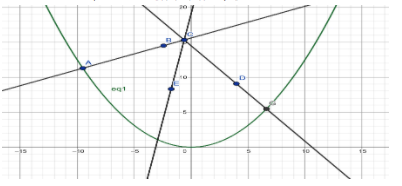
Find the locus of the point of intersection of those normal to the parabola \[{{x}^{2}}=8y\] which are at right angles to each other.
Answer
514.8k+ views
Hint- Apply the concept of co-normal points over here. Co normal points are the feet of any three normal that are drawn from any point. Note that, there can be at the most, only 3 normals possible to be drawn on a parabola from a single point. You’ll eventually get a cubic equation in their slopes, and apply general results of cubic equations, like sum of roots, sum of product of roots taken two at a time, and the product of the roots, to get to the final answer.
Let’s assume a parabola \[{{x}^{2}}=8y\].

General equation of normal of the parabola \[{{x}^{2}}=8y\]is
\[x=ym-2bm-b{{m}^{3}}\] …………………. (1)
Where \[\dfrac{1}{m}=\]slope of normal
As we can see that the equation of normal \[x=ym-2bm-b{{m}^{3}}\]is a $3$ degree polynomial in $m$.
Therefore; this equation will have three solutions.
It means three normals can be drawn on a parabola from one point, lying anywhere.
Let the point of the intersection of normal is \[C\left( h,k \right)\].
Therefore, point $C$ will satisfy the equation (1).
From equation (1) and the point $C$, we get :
\[h=km-2bm-b{{m}^{3}}\]
\[\Rightarrow b{{m}^{3}}+m\left( 2b-k \right)+h=0\] ……….. (2)
Let \[{{m}_{1}},{{m}_{2}}\,and\,{{m}_{3}}\]are solutions of equation (2).
Therefore,
\[{{m}_{1}}+{{m}_{2}}+{{m}_{3}}=0\],
\[{{m}_{1}}{{m}_{2}}+{{m}_{2}}{{m}_{3}}+{{m}_{3}}{{m}_{1}}=\dfrac{\left( 2b-k \right)}{b}\] and
\[{{m}_{1}}{{m}_{2}}{{m}_{3}}=-\dfrac{h}{b}\] …….. (3)
Let’s assume \[{{m}_{1}}\,and\,{{m}_{2}}\,\]are the slopes of two normals which intersect normally each other at point $C$.
Therefore, the product of their slopes \[=-1\]
\[{{m}_{1}}{{m}_{2}}=-1\] ………. (4)
Put the value of \[{{m}_{1}}{{m}_{2}}=-1\]in equation (3)
Therefore, from equation (3) and (4), we get :
\[\left( -1 \right){{m}_{3}}=-\dfrac{h}{b}\]
\[\Rightarrow {{m}_{3}}=\dfrac{h}{b}\] ……… (5)
As \[{{m}_{3}}\]is also a solution to equation (2), it will satisfy the equation.
Therefore, from equation (2) and (5)
Put the value of \[{{m}_{3}}=\dfrac{h}{b}\] in equation (3), we get :
\[\Rightarrow b{{\left( \dfrac{h}{b} \right)}^{3}}+\dfrac{h}{b}\left( 2b-k \right)+h=0\]
\[\Rightarrow {{\dfrac{h}{{{b}^{2}}}}^{3}}+2h-\dfrac{hk}{b}+h=0\]
Taking $h$ common, we get :
\[\Rightarrow h\left( \dfrac{{{h}^{2}}}{{{b}^{2}}}+3-\dfrac{k}{b} \right)=0\]
\[\therefore \dfrac{{{h}^{2}}}{{{b}^{2}}}+3-\dfrac{k}{b}=0\]
\[\Rightarrow {{h}^{2}}+3{{b}^{2}}-kb=0\]
\[\Rightarrow {{h}^{2}}=b\left( k-3b \right)\] ……….. (6)
Interchange \[\left( h,k \right)\to \left( x,y \right)\]and equation (6) becomes
\[\Rightarrow {{x}^{2}}=b\left( y-3b \right)\] …………. (7)
According to the question, the given parabola is \[{{x}^{2}}=8y\].
Comparing with the general equation of a parabola \[{{x}^{2}}=4ay\]
\[{{x}^{2}}=4by\] ……… (A)
\[{{x}^{2}}=8y\] ………… (B)
From (A) and (B),
\[b=2\] Put this value in equation (7)
Form equation (7)
\[\Rightarrow {{x}^{2}}=2\left( y-3\times 2 \right)\]
\[\Rightarrow {{x}^{2}}=2\left( y-6 \right)\] Locus of point of intersection.
Note: We can also start from parabola \[{{y}^{2}}=4ax\]and there general equation of normal\[y=xm-2am-a{{m}^{3}}\]. But at the end of calculation just interchange the values
\[x\to y,y\to x\,and\,a\to b\].
Let’s assume a parabola \[{{x}^{2}}=8y\].

General equation of normal of the parabola \[{{x}^{2}}=8y\]is
\[x=ym-2bm-b{{m}^{3}}\] …………………. (1)
Where \[\dfrac{1}{m}=\]slope of normal
As we can see that the equation of normal \[x=ym-2bm-b{{m}^{3}}\]is a $3$ degree polynomial in $m$.
Therefore; this equation will have three solutions.
It means three normals can be drawn on a parabola from one point, lying anywhere.
Let the point of the intersection of normal is \[C\left( h,k \right)\].
Therefore, point $C$ will satisfy the equation (1).
From equation (1) and the point $C$, we get :
\[h=km-2bm-b{{m}^{3}}\]
\[\Rightarrow b{{m}^{3}}+m\left( 2b-k \right)+h=0\] ……….. (2)
Let \[{{m}_{1}},{{m}_{2}}\,and\,{{m}_{3}}\]are solutions of equation (2).
Therefore,
\[{{m}_{1}}+{{m}_{2}}+{{m}_{3}}=0\],
\[{{m}_{1}}{{m}_{2}}+{{m}_{2}}{{m}_{3}}+{{m}_{3}}{{m}_{1}}=\dfrac{\left( 2b-k \right)}{b}\] and
\[{{m}_{1}}{{m}_{2}}{{m}_{3}}=-\dfrac{h}{b}\] …….. (3)
Let’s assume \[{{m}_{1}}\,and\,{{m}_{2}}\,\]are the slopes of two normals which intersect normally each other at point $C$.
Therefore, the product of their slopes \[=-1\]
\[{{m}_{1}}{{m}_{2}}=-1\] ………. (4)
Put the value of \[{{m}_{1}}{{m}_{2}}=-1\]in equation (3)
Therefore, from equation (3) and (4), we get :
\[\left( -1 \right){{m}_{3}}=-\dfrac{h}{b}\]
\[\Rightarrow {{m}_{3}}=\dfrac{h}{b}\] ……… (5)
As \[{{m}_{3}}\]is also a solution to equation (2), it will satisfy the equation.
Therefore, from equation (2) and (5)
Put the value of \[{{m}_{3}}=\dfrac{h}{b}\] in equation (3), we get :
\[\Rightarrow b{{\left( \dfrac{h}{b} \right)}^{3}}+\dfrac{h}{b}\left( 2b-k \right)+h=0\]
\[\Rightarrow {{\dfrac{h}{{{b}^{2}}}}^{3}}+2h-\dfrac{hk}{b}+h=0\]
Taking $h$ common, we get :
\[\Rightarrow h\left( \dfrac{{{h}^{2}}}{{{b}^{2}}}+3-\dfrac{k}{b} \right)=0\]
\[\therefore \dfrac{{{h}^{2}}}{{{b}^{2}}}+3-\dfrac{k}{b}=0\]
\[\Rightarrow {{h}^{2}}+3{{b}^{2}}-kb=0\]
\[\Rightarrow {{h}^{2}}=b\left( k-3b \right)\] ……….. (6)
Interchange \[\left( h,k \right)\to \left( x,y \right)\]and equation (6) becomes
\[\Rightarrow {{x}^{2}}=b\left( y-3b \right)\] …………. (7)
According to the question, the given parabola is \[{{x}^{2}}=8y\].
Comparing with the general equation of a parabola \[{{x}^{2}}=4ay\]
\[{{x}^{2}}=4by\] ……… (A)
\[{{x}^{2}}=8y\] ………… (B)
From (A) and (B),
\[b=2\] Put this value in equation (7)
Form equation (7)
\[\Rightarrow {{x}^{2}}=2\left( y-3\times 2 \right)\]
\[\Rightarrow {{x}^{2}}=2\left( y-6 \right)\] Locus of point of intersection.
Note: We can also start from parabola \[{{y}^{2}}=4ax\]and there general equation of normal\[y=xm-2am-a{{m}^{3}}\]. But at the end of calculation just interchange the values
\[x\to y,y\to x\,and\,a\to b\].
Recently Updated Pages
Master Class 11 Economics: Engaging Questions & Answers for Success

Master Class 11 Business Studies: Engaging Questions & Answers for Success

Master Class 11 Accountancy: Engaging Questions & Answers for Success

The correct geometry and hybridization for XeF4 are class 11 chemistry CBSE

Water softening by Clarks process uses ACalcium bicarbonate class 11 chemistry CBSE

With reference to graphite and diamond which of the class 11 chemistry CBSE

Trending doubts
10 examples of friction in our daily life

One Metric ton is equal to kg A 10000 B 1000 C 100 class 11 physics CBSE

Difference Between Prokaryotic Cells and Eukaryotic Cells

State and prove Bernoullis theorem class 11 physics CBSE

What organs are located on the left side of your body class 11 biology CBSE

How many valence electrons does nitrogen have class 11 chemistry CBSE




